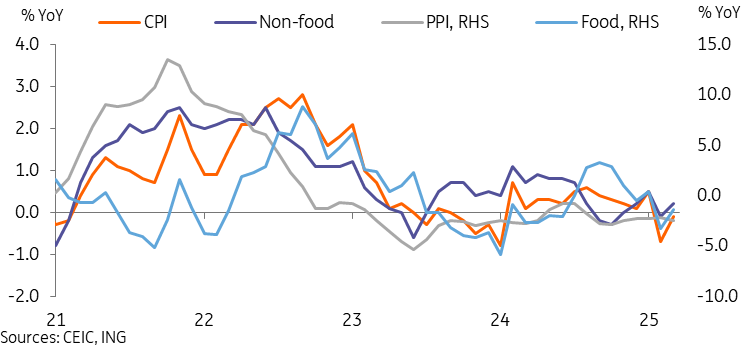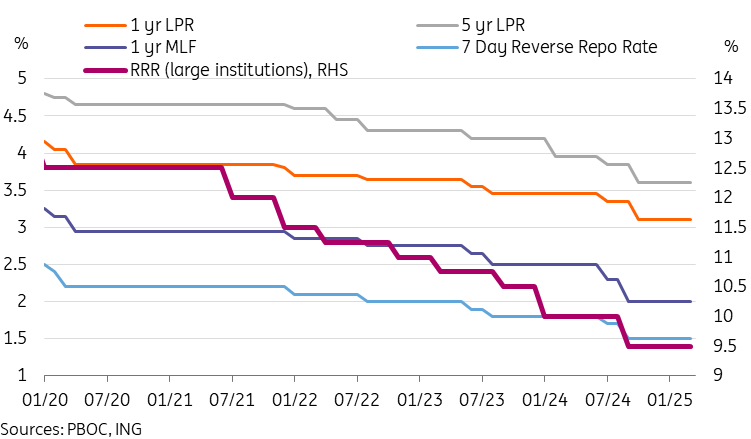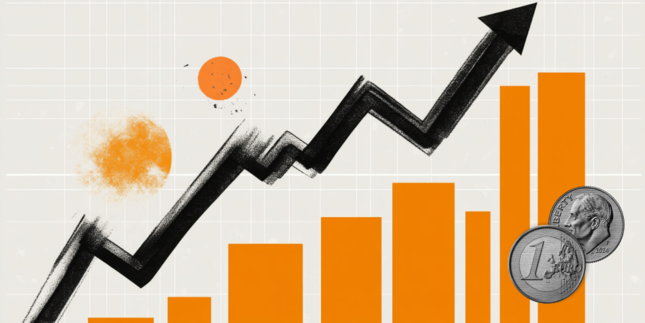CPI inflation failed to rebound above the zero threshold in March as price pressures persist across the board. Combined with a sharp escalation of tariffs, this sets up a suitable window for the People's Bank of China to resume monetary policy easing
Deflationary pressures remain significant
CPI inflation rose slightly from -0.7% year-on-year to -0.1% YoY in March, coming in softer than forecasts as we saw broad-based price pressures across the economy.
Both food and non-food inflation slowed in month-on-month terms, bringing the YoY inflation rates to -1.4% and 0.2% respectively.
In food inflation, the biggest drags on inflation were fresh vegetables (-6.8%) as well as beef (-10.8%) and mutton (-5.4%). Pork prices (6.7%) continued to be the main support for food inflation but have been declining in sequential terms for several months now. The pork cycle has been on a downturn, with sequential price declines in five of the past six months, but trade disruptions could throw a wrench in the cycle.
In non-food inflation, we can see the impact of price competition in many categories. The transportation facility category including cars was down to -4.0% YoY. The communication facility category which covers various electronics remained positive at 1.4% YoY but saw a third straight month of sequential price declines. Rents remained in negative inflation for a twelfth consecutive month at -0.1% YoY, but eked out a slight MoM gain of 0.1% and could be soon returning above the zero bound.
To no one's surprise, PPI inflation remained negative for the 30th consecutive month as well amid falling raw material prices.
As tariffs on US agricultural products come into effect, it's possible this could begin to pressure food prices higher, perhaps most notably through the pork cycle which has historically had significant exposure to US soybean imports. It's uncertain at this point if China will be able to source these imports from other areas without experiencing a notable price hike.
However, non-food prices will likely face further pressure, as US tariffs will worsen the overcapacity issues and likely prompt further price competition as exporters previously selling to the US market will need to find new buyers.
A question is if this year's measures to boost domestic demand will help restore inflation to a healthier trajectory. While this makes sense on an intuitive level, currently policy support for consumption is mostly focused on the trade-in policy, which in essence subsidises consumption through providing discounts and as such should do little to move price levels higher. It's possible that if consumption-support policies are expanded toward general use consumption vouchers, or if we see minimum wage hikes or tax bracket adjustments, these would be more conducive to moving inflation higher.
Price pressures persist as CPI and PPI inflation both remained negative

Weak inflation read and mounting tariff pressure should prompt PBOC easing
In light lower-than-expected inflation in the first quarter, as well as an escalation of tariffs which will worsen the overcapacity problem and intensify price competition, we are downgrading our 2025 CPI inflation forecast from 0.7% to 0.0% YoY.
At the Two Sessions, policymakers vowed a "moderately loose" monetary policy stance, and noted that we'd see timely cuts in interest rates and required reserve ratios. With inflation still failing to break above zero, and the economy facing new challenges this year as the trade war has quickly escalated to full throttle, we think we are now in a favourable period for the People's Bank of China to provide further easing beyond the open market operations that they have been conducting in the past weeks.
Given last year's experience, we think it is more likely we could see a bundled package of monetary policy easing, as last year's piecemeal measures had a smaller impact in stabilising market confidence. Our forecasts have looked for 30bp of cuts to the 7-day reverse repo rate, and 100bp of RRR cuts, and we expect this could be front loaded in the second or third quarter. If trade tensions persist or if there are signs that domestic demand has not picked up sufficiently through the year, it's possible to see more aggressive easing as well.
PBOC could soon cut rates and RRR to support the economy

Read the original analysis: Soft March CPI strengthens case for rate cuts in China
Content disclaimer: This publication has been prepared by ING solely for information purposes irrespective of a particular user's means, financial situation or investment objectives. The information does not constitute investment recommendation, and nor is it investment, legal or tax advice or an offer or solicitation to purchase or sell any financial instrument. Read more here: https://think.ing.com/content-disclaimer/
Recommended Content
Editors’ Picks

Gold pulls back from record highs of $3,500
Gold price retreats from $3,500, new all-time high, in the European session on Tuesday as buyers pause for a breather amid overbought conditions on short-term charts. Any meaningful corrective downfall, however, still seems elusive on persistent US Dollar downtrend.

EUR/USD battles 1.1500 as US Dollar looks to stabilize
EUR/USD is battling 1.1500 in the European session on Tuesday. The pair loses traction as the US Dollar finds its feet even as investors remain wary of the US financial stability amid Trump's attacks on Fed Chair Powell. Speeches from ECB and Fed officials are on the radar.

GBP/USD reverses below 1.3400 as US Dollar pauses decline
GBP/USD is back below the 1.3400 mark in the European trading hours on Tuesday, feeling the heat from the pause in the US Dollar decline. But the pair's further dowside appears limited as fears of a US economic slowdown and concerns about the Fed's independence will continue to remain a headwind for the Greenback.

3% of Bitcoin supply in control of firms with BTC on balance sheets: The good, bad and ugly
Bitcoin disappointed traders with lackluster performance in 2025, hitting the $100,000 milestone and consolidating under the milestone thereafter. Bitcoin rallied past $88,000 early on Monday, the dominant token eyes the $90,000 level.

Five fundamentals for the week: Traders confront the trade war, important surveys, key Fed speech Premium
Will the US strike a trade deal with Japan? That would be positive progress. However, recent developments are not that positive, and there's only one certainty: headlines will dominate markets. Fresh US economic data is also of interest.

The Best brokers to trade EUR/USD
SPONSORED Discover the top brokers for trading EUR/USD in 2025. Our list features brokers with competitive spreads, fast execution, and powerful platforms. Whether you're a beginner or an expert, find the right partner to navigate the dynamic Forex market.